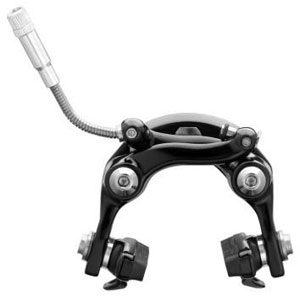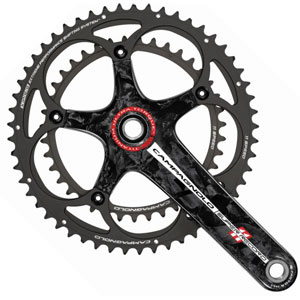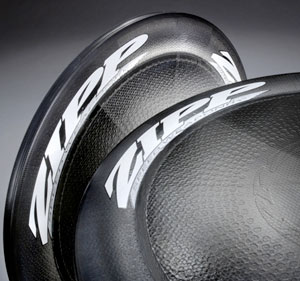Campagnolo and TT

We can quibble over the 20-year wait, or we can celebrate the fact that iconic component maker Campagnolo has at long last introduced the necessary elements of its gruppo specific to timed racing. Me? I've been quibbling for all 20 of those years, so, I'll celebrate.
The precision Italian parts maker has just introduced a series of parts in four component categories. We'll look at these one-by-one.
Bar end shifters
As with Shimano, Campagnolo eked by over the past two decades on a shifter that wasn't ever designed as a bar-end. In fact, the design predated the aero bar, and was originally intended for road bar plug-ins, used for touring, tandems and cyclocross.
Shimano (in its non-electronic groups) is still living off the largesse of that mold, but Campagnolo follows SRAM in making a dedicated timed racing bar-end shifter.
Like SRAM, the new Campy "Bar-End Controls" feature a "Back-to-Zero" function analogous to SRAM's Return-to-Center. While Campy's shifter paddles may be somewhat more ergonomic than SRAM's minimalist R2C's, the big value here is that the new shifters open Campy's 11-speed drivetrain up to timed racing (its prior thumb shifters were only 10-speed compatible).
The new Bar End Controls come in both 11-speed and 10-speed, with two 11-speed models: carbon and aluminum. If you're still stocked up with bikes carrying 10-speed Campy groups, an aluminum version of the shifter is available for 10-speed shift systems (the carbon version isn't available in 10-speed).
Further, these self-centering shifters allow for 3 clicks per lever swing—especially handy when shifting front and rear derailleurs concurrently.
Plug-in Brake Levers
For a generation Campy-philes, and Campy-sponsored athletes, have had as their only option the use of a pre-Ergopower (1980s vintage) brake lever mounted onto a pursuit bar (or an Ergopower lever mounted on a pursuit bar, which meant no bar-end shifting). This, if you want to keep the entire gruppo Campy.
This has been a major hassle, because the contour of such a lever matched the contour of a road race bar. These sorts of levers tend to bottom out against a pursuit bar, not to mention the inability to easily route the brake cables.
Enter a slick plug-in lever with Campagnolo's attention to detail. It's a spring-loaded pursuit lever in both aluminum and carbon models that has one feature unique to products in this category: the inclusion of Campy's lever-actuated brake caliper opener. This is one of the two major features differentiating Campy's Ergopower from Shimano's STI—and subsequently SRAM's DoubleTap (the other is the way Ergopower executes a downshift).
Campagnolo believes that the spreading of the calipers for the exit/entry of the wheel ought to be at the lever, not at the caliper. This has made Campy groupkits hard to spec on TT bikes, because nobody made a lever with this method of caliper spread. Therefore—because Campy's brake calipers do not have a spreading mechanism—the lack of a lever with such a feature precluded the use of any of Campy's calipers. In essence, Campy was out of the brake business altogether in timed race bikes.
This new lever not only allows for the use of calipers unencumbered by the need of a spreading mechanism, it's also a great lever for TRP and proprietarily-made TT calipers. Think, for example, of all the new TT bikes with calipers underneath the chain stay. Do you really want to mess with try to open those calipers to get your wheel in and out? This new Campy lever is a great solution for all these calipers—front and rear—in non-traditional placements (behind the fork, inside the fork, and whatnot).

U-Brake Calipers
The third new component made as a part of Campy's timed race suite is a set of U-brakes. These come in either a side-pull or center-pull config. The side-pull brake caliper is great for bikes like QR's CD0.1 and Kuota's Kueen K, that have until now been tied to the brake calipers made by TRP. My biggest beef with the TRP brakes has been the difficulty in aligning the pads to the rims.
Yes, Campagnolo has been a maddening company in many ways—typically with regard to an attitude that's just out of step with today's customer-driven attention-to-service—however, this company is reliably function-driven. I confess that I haven't yet tested these calipers as to the ability to their side-to-side adjustment, but, I'm reasonably confident Campy wouldn't put into the market a caliper that isn't adjustable. Still, I can't state with certainty that the caliper fixes what's been lacking in TRP's design. But one can hope.
Speaking of hope, one hopes that Campagnolo will become more interested in original equipment spec, specifically in triathlon and, more specifically, with regard to this brakeset. Until recent years, Campy has considered itself an aftermarket parts company, at least in the North American market. I hear this is changing. In timed race, what we see is a move toward getting the rear caliper out of its traditional placement, situated just above or below the chain stay. Fine. What I'd like to see are more center pull calipers, because the side pull version requires a cable casing that tends to interfere with the left side crank arm. So much the better if these frames are designed from the ground up with a center pull rear brake in mind. But, not all companies have the wherewithal to design and make a good rear brake. Perhaps it's Campy to the rescue.
However, Campy should not get miserly in its OE pricing (as it has traditionally been). It needs to understand that it shouldn't try to make margin on this brake caliper. Rather, it needs to see this caliper as a Trojan Horse, through which Campy spec can end up on the rest of the bike. For example, if this brake caliper is priced aggressively, this opens the door for product managers to want to spec the corresponding lever and—why not?—the rest of the group.
Campagnolo should also make this center pull caliper as a front brake (only the longer brake bolt is required) and market this also to OEMs who're striving to make nosecone style forks mated with center pull brakes. Note to Campy: make a few phone calls—your rear center pull brake may solve certain front center pull problems for bike makers.

Crankset
This is the one area where Campagnolo understands engineering, industrial design, and manufacturing processes, but fails to understand the market to which it intends to sell.
The point of the new TT crank is this: Campy can make a crankset with 55×42 rings and achieve the same rigidity as its typical crank spec'd with 53×39 rings. Well, that's great, but, the issues are these:
1. The market for all this stuff is triathlon, not time trial. So, we need to see what triathletes need, not what time trialists need.
2. The bike ride in triathlon does not include any riding that overmuch torques the crank. While the sprinter in a road race might generate 1500 or even 2000 watts, a professional triathlete will never generate more than 500 watts. This, because the bike ride in a triathlon is an exercise in who can whisper the loudest. What's required is the "quietest", most even-paced, application of 250, 280, 300, or 320 watts over a period of 25, 56 or 112 miles (the heavier the rider, the shorter the distance, the more the power required, but, even in an Olympic distance triathlon an athlete will rarely if ever average more than 350 watts).
3. Timed racing typically requires a reasonably high cadence, obviating the need of large chain rings. In such cases as cadences are lower (the longer the distance, the lower the cadence), speeds also are lower. However, in these cases, power is also lower. So, in most cases the need for a 55-tooth chainring is not there. However, if it is there, the stiffness requirement is not.
In short, Campagnolo made a TT crank, but, I'll be guessing the TT riders won't need it. But the road sprinters will.
Conclusion
I am a Campyphile. My everyday riders (road bikes, not tri bikes) have featured Ergopower shifting and Campy groups throughout for 15 years. My garage has been graced by Chorus, Record an Super Record groups hung on bike after bike. And this is in keeping with my history as a cyclist—my first bikes, in the 1970s, had Campagnolo Nuovo Record parts on them.
That said, for 25 years Campy has resisted both OE sales and the sport of triathlon. While it has sponsored, in the past, notable athletes like Spencer Smith, Michellie Jones and Greg Welch, its posture has been visibly, undeniably, triathlon-ambivalent.
But all that is water under the bridge. Cycling's most historically significant component maker has finally turned its attention our way. That established, Campagnolo will, probably within a matter of months, unveil an electronic group. When Shimano announced Di2 and brought it to market, it did so with bar-end and pursuit shifters alongside its STI levers. Will Campagnolo do the same? If so, this is an acknowledgement of its continued commitment to timed racing. If not, fine, but it then needs to express, at the time of the launch, a timetable for the timed race electronic components.
Between now and then, I have nothing but praise for the company that's exemplified attention to precision and function for three-quarters of a century. Campagnolo, welcome to triathlon. Bravo.



